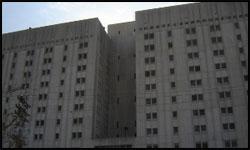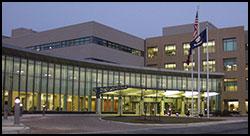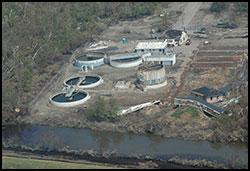Background for the Alternative Arrangements
Alternative Arrangements (AA) were developed in 2005 to address the incomplete information surrounding FEMA Public Assistance (PA) recovery projects in the NOMA and their potential significant cumulative environmental effect upon the various resources in the area. AA enables FEMA to consider the potential for significant direct, indirect, and cumulative impacts to the human environment from its funding the reconstruction of critical physical infrastructure in NOMA through its PA grant program. The arrangement has been developed in consultation with the Council on Environmental Quality pursuant to National Environmental Policy Act (NEPA) regulations found in 40 CFR 1506.11 and DHS Instruction Manual 023-01-001-01, Rev 01.
FEMA’s determination of the need for the arrangement was based on incomplete information that: (1) the number and complexity of FEMA-funded actions, when evaluated with all future Federal, State, and local actions in the area, would cause significant environmental impacts and (2) due to the nature of the disaster, would need to be processed in an amount of time that would not have allowed for a normal environmental impact statement process. These alternative arrangements enable timely grant applications to restore safe and healthful living conditions in NOMA while observing the requirements and objectives of the NEPA.
Although the restoration of eligible infrastructure substantially to its pre-disaster conditions is excluded from NEPA by Section 5159 of the Stafford Act, FEMA anticipates that the applications for NOMA will more strongly reflect future demands than returning to pre-disaster conditions. Proposed projects will not necessarily be the same size, nature, or location; will use current building codes; and take advantage of current urban planning principles and hazard mitigation opportunities.
The following documents contain a description of Alternative Arrangements, the CEQ letter approving Alternative Arrangements, and the Federal Register announcement for Alternative Arrangements:
Alternative Arrangements (PDF 51KB, TXT 13KB)
Approval of the Alternative Arrangements by CEQ for DHS (PDF 41KB, TXT 1KB)
Federal Register Announcement of NEPA Alternative Arrangements (PDF 65KB, TXT 27KB)
Alternative Arrangements Criteria
While the Public Assistance Grant Program addresses various types of emergency work (debris removal and emergency protective measures), and permanent work (roads, bridges, buildings and structures, water control facilities, utilities, and parks and recreation areas) the Alternative Arrangements will cover only those that can be considered critical infrastructure projects that are essential in providing the basic life, health and safety sustaining services within the NOMA and damaged as a result of Hurricane Katrina. The NOMA includes Orleans, Jefferson, St. Bernard, Plaquemines, St. Tammany, St. Charles, and St. John the Baptist parishes. For ease of planning, analysis, review and public involvement, these critical infrastructure projects will be grouped into the following six infrastructure categories. Below you will find a summary and definition of each project type.
- Detention centers (jailhouses)
- Government and court administration buildings
- Hospitals and health care facilities
- Permanent police and fire stations
- Permanent schools
- Utilities and wastewater treatment plants
Detention Centers (jailhouses)
 A detention center (jailhouse) is a facility used to detain individuals who are in the lawful custody of the government. The repair and rebuilding of federal, state, parish, and municipal jail or prison facilities for both juveniles and adults are eligible for funding. Some examples of detention centers are: juvenile hall, local or parish prisons, prison work camps, or parish or state jails.
A detention center (jailhouse) is a facility used to detain individuals who are in the lawful custody of the government. The repair and rebuilding of federal, state, parish, and municipal jail or prison facilities for both juveniles and adults are eligible for funding. Some examples of detention centers are: juvenile hall, local or parish prisons, prison work camps, or parish or state jails.
Government and Court Administration Buildings
 Eligible buildings in this category can be used by federal, state, parish, or municipal governments. Examples of these facilities are:
Eligible buildings in this category can be used by federal, state, parish, or municipal governments. Examples of these facilities are:
- the federal district courts,
- the Louisiana circuit courts,
- administration buildings,
- garages,
- department of motor vehicle facilities,
- Social Security Administration offices,
- maintenance yards,
- the Orleans Parish Notarial Archives, and
- city hall buildings.
Hospitals and Health Care Facilities
 These include all facilities that provide medical, diagnostic, and major surgery for care and treatment of sick and injured persons on an inpatient basis under the supervision of licensed physicians and nurses. While private doctors' offices are not covered under this type of project, local clinics and other outpatient facilities are eligible for funding as long as they are nonprofit and open to the public. Surgery centers, community health clinics, hospice facilities, and parish-run rehabilitation centers are also eligible to receive funding.
These include all facilities that provide medical, diagnostic, and major surgery for care and treatment of sick and injured persons on an inpatient basis under the supervision of licensed physicians and nurses. While private doctors' offices are not covered under this type of project, local clinics and other outpatient facilities are eligible for funding as long as they are nonprofit and open to the public. Surgery centers, community health clinics, hospice facilities, and parish-run rehabilitation centers are also eligible to receive funding.
Permanent Police and Fire Stations
 The facilities covered are federal, state, parish, and municipal. Some examples of police and fire stations are:
The facilities covered are federal, state, parish, and municipal. Some examples of police and fire stations are:
- the FBI office,
- Louisiana state police offices,
- parish sheriff offices,
- local police headquarters, and
- all fire stations.
 A permanent school is an educational institution where learning takes place. In Louisiana, schools are governed by school boards that are administered at a parish or state level.
A permanent school is an educational institution where learning takes place. In Louisiana, schools are governed by school boards that are administered at a parish or state level.
Utilities and Wastewater Treatment Plants
 Some examples of these facilities are:
Some examples of these facilities are:
- power generation facilities,
- sewage collection and treatment facilities,
- water treatment and delivery systems, and
- telephone and utility infrastructure.
